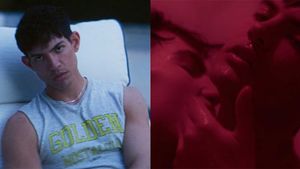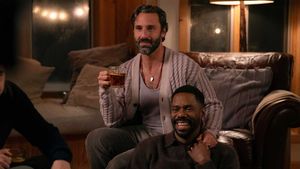"Anytime you get a group of gay girls together, you are guaranteed someone's slept with someone else, who has slept with someone else, who has slept with someone else in that room," says Alice Pieszecki in the third episode ofThe L Word as she pitches "the chart" to her editor. Though the article is shot down, she continues to document the sexual relationships of Los Angeles' lesbian and bisexual women throughout the show, insisting any lesbian can be connected in six degrees. But, even keep-a-cardboard-cutout-of-my-ex-gilfriend-next-to-a-creepy-shrine-Alice wasn’t neurotic enough to chart the sexual escapades of queer women in early twentieth century Europe, so instead the responsibility has fallen on my lit-gossip-obsessed shoulders. And I have to say, Alice was totally missing out.
But, even keep-a-cardboard-cutout-of-my-ex-gilfriend-next-to-a-creepy-shrine-Alice wasn’t neurotic enough to chart the sexual escapades of queer women in early twentieth century Europe, so instead the responsibility has fallen on my lit-gossip-obsessed shoulders. And I have to say, Alice was totally missing out.
At age 71, Dame Ethel Smyth, a composer and member of the English women's suffrage movement, fell for Virginia Woolf, the prolific English modernist who wrote Mrs Dalloway, To the Lighthouse, A Room of One's Own, and Orlando. Woolf, who was more than 20 years Smyth's junior at the time, described the situation as, "at once horrid and melancholy-sad," and, "like being caught by a giant crab."
Smyth and Woolf became friends, but Smyth's love remained unrequited. Still, Woolf slept with someone, who slept with someone, who slept with someone, who slept with Smyth. If Alice had made an L-Word-esque chart for Virginia Woolf, she and the "giant crab" would be connected by four degrees. Woolf and Ethel Smyth, Henry W. and Albert A. Berg Collection, The New York Public Library.
Woolf and Ethel Smyth, Henry W. and Albert A. Berg Collection, The New York Public Library.
Virginia Woolf only had documented sexual relationships with two people: her husband, Leonard Woolf, and prolific writer and garden designer, Vita Sackville-West. When I started Woolf’s chart, I was worried it might fizzle out quickly for that reason. Fortunately, I couldn’t have been more wrong. The chart is still expanding.
 We choose who we sleep with, but we don’t always choose whether or not we’re connected to people. Woolf and Smyth are connected, just not in the way Smyth would’ve liked. Here’s the breakdown of Virginia Woolf’s connection to Ethel Smyth:
We choose who we sleep with, but we don’t always choose whether or not we’re connected to people. Woolf and Smyth are connected, just not in the way Smyth would’ve liked. Here’s the breakdown of Virginia Woolf’s connection to Ethel Smyth:
"I sometimes think that if I married you, I could have everything—and then—is it the sexual side of it that comes between us? As I told you brutally the other day, I feel no physical attraction in you. There are moments—when you kissed me the other day was one—when I feel no more than a rock. And yet your caring for me as you do almost overwhelms me. It is so real, and so strange."
—Virginia to Leonard Woolf, May 1, 1912
Despite Virginia’s reservations about marrying Leonard Woolf, the couple was wed on August 10, 1912. It was on their honeymoon that Leonard discovered Virginia’s dislike of sex, which they blamed on the sexual abuse she endured as a child. Leonard and Virginia Woolf during their engagement c. 1912.
Leonard and Virginia Woolf during their engagement c. 1912.
Still, the couple had a strong, loving, and supportive relationship. Leonard cared for Virginia during bouts of mental illness. The couple also founded Hogarth Press together.
In the suicide note she left for him in 1941, Virginia wrote to Leonard:
"You have been entirely patient with me and incredibly good. I want to say that — everybody knows it. If anybody could have saved me it would have been you. Everything has gone from me but the certainty of your goodness. I can’t go on spoiling your life any longer. I don’t think two people could have been happier than we have been."
Leonard also knew about Virginia’s affair with Vita Sackville-West, and stayed out of it. He considered the affair important to her happiness.

"Look here Vita — throw over your man, and we’ll go to Hampton Court and dine on the river together and walk in the garden in the moonlight and come home late and have a bottle of wine and get tipsy, and I’ll tell you all the things I have in my head, millions, myriads — They won’t stir by day, only by dark on the river. Think of that. Throw over your man, I say, and come."
—Virginia Woolf to Vita Sackville-West, 1927
Virginia Woolf and Vita-Sackville West first met in 1922. Virginia invited Vita to publish a novel with Hogarth Press, and eventually their work relationship became a close friendship. Virginia and Vita at Monk's House, 1933, photographed by Leonard Woolf.
Virginia and Vita at Monk's House, 1933, photographed by Leonard Woolf.
In 1923, Vita and her husband, Harold Nicholson, visited Leonard and Virginia Woolf. Virginia wrote in her diary:
"We had a surprise visit from the Nicholson’s. She [Vita Sackville-West] is a pronounced sapphist, & may, thinks Ethel Sands, have an eye on me, old though I am."
They remained friends for years before beginning an affair in December of 1925. A head-over-heels Virginia took to her diary again to write about her deep admiration and desire for Vita:
"Vita shines in the grocers shop in Sevenoaks…pink glowing, grape clustered, pearl hung…There is her maturity and full-breastedness: her being so much in full sail on the high tides, where I am coasting down backwaters; her capacity I mean to take the floor in any company, to represent her country, to visit Chatsworth, to control silver, servants, chow dogs; her motherhood…her in short (what I have never been) a real woman."
In January of 1926, Vita wrote a longing letter to Virginia from Milan:
"I am reduced to a thing that wants Virginia. I composed a beautiful letter to you in the sleepless nightmare hours of the night, and it has all gone: I just miss you, in a quite simple desperate human way. You, with all your un-dumb letters, would never write so elementary a phrase as that; perhaps you wouldn't even feel it. And yet I believe you'll be sensible of a little gap."
Virginia wrote asking Vita to "throw over your man." For a time, Vita did, though she was hesitant to continue an affair with Virginia for the sake of her mental health. She wrote to her husband, Harold, about the affair in August 1926:
"I am scared to death of arousing physical feelings in her, because of the madness. I don’t know what effect it would have, you see; it is a fire with which I have no wish to play. […] Besides, Virginia is not the sort of person one thinks of in that way. There is something incongruous and almost indecent in the idea. I have gone to bed with her (twice), but that’s all."
Virginia, for her part, was so enamored with Vita that she based the gender-swapping protagonist of her novel Orlando on Sackville-West. Vita’s son, Nigel Nicolson, later called Orlando "the longest and most charming love letter in literature." Orlando: A Biography. New York: Crosby Gaige, 1928. Vita Sackville-West pictured as Orlando.
Orlando: A Biography. New York: Crosby Gaige, 1928. Vita Sackville-West pictured as Orlando.

"Oh, Mitya, come away, let’s fly, Mitya darling — if ever there were two entirely primitive people, they are surely us: let’s go away and forget the world and all its squalor — let’s forget such things as trains, and trams, and servants, and streets, and shops, and money, and cares and responsibilities. Oh god! how I hate it all — you and I, Mitya, were born 2000 years too late, or 2000 years too soon."
—Violet Trefusis to Vita Sackville-West, 1918
Vita Sackville-West and Violet Trefusis (née Keppel) began their affair before Virginia and Vita met. Vita would dress in men’s clothing, and meet up with Violet so they could run around London in public as lovers. During their escapades, she took on the name Julian. Vita wrote about their affair in her novel Challenge, depicting herself and Violet as Julian and Eve, and turning the romance into a heterosexual one to evade censorship.
Their affair ended shortly after Violet Trefusis reluctantly married Denys Trefusis at the urging of her mother, though they rekindled their relationship after World War II. Violet Trefusis c. 1920.
Violet Trefusis c. 1920.
Violet and Virginia’s relationship to each other was tense at best. Woolf based Orlando's Russian princess, Sasha, on Violet Tefusis. Violet was not impressed. In fact, she was annoyed by the way Woolf interwove fact and fiction in Orlando, (an annoyance that was probably compounded by the fact that Woolf didn’t publish her novel Tandem through Hogarth Press) and engaged in a literary debate with her that lasted until Woolf’s death.
 While Violet’s relationship with Vita was probably the most formative relationship of her life, she also had a relationship with Winnaretta Singer—musical patron, heiress to the Singer sewing machine fortune, and Princess Edmond de Polignac—from 1923 to 1933.
While Violet’s relationship with Vita was probably the most formative relationship of her life, she also had a relationship with Winnaretta Singer—musical patron, heiress to the Singer sewing machine fortune, and Princess Edmond de Polignac—from 1923 to 1933. Winnaretta Singer via Foundation Singer-Polignac.
Winnaretta Singer via Foundation Singer-Polignac.
Singer was known to be a lesbian within private social circles, but was married at the age of 22 to Prince Louis de Scey-Montbéliard. On their wedding night, she reportedly climbed on top of an armoire and threatened to kill herself if the groom tried anything. Their marriage was annulled five years later.
Singer had affairs with numerous women, many of whom were closeted and married. An angry husband of one of her lovers once showed up outside Singer’s window and shouted, "If you are half the man I think you are, you will come out here and fight me."
Singer eventually fell into a mutually respectful lavender marriage with the gay Prince Edmond de Polignac. They opened a salon together, and hosted Marcel Proust, Colette, Claude Monet, Jean Cocteau, and others.
Winnaretta Singer and Virginia Woolf are connected beyond lines on a chart. Singer had a great deal of respect for Woolf, and wrote to her shortly after their first meeting, "Dear Mrs Woolf, (When will you allow me to call you Virginia, and when will you call me Winnaretta?)"
Meanwhile, the forever snarky Virginia Woolf wrote of Singer in a 1937 letter to Dorothy Bussy: "to look at [her] you’d never think she ravished half the virgins in Paris."
 Dame Ethel Smyth may have been a prolific composer (best known for her opera The Wreckers), and an active member of the women’s suffrage movement, but she wasn’t always lucky in love.
Dame Ethel Smyth may have been a prolific composer (best known for her opera The Wreckers), and an active member of the women’s suffrage movement, but she wasn’t always lucky in love.
 Ethel Smyth from the United States Library of Congress Prints and Photographs.
Ethel Smyth from the United States Library of Congress Prints and Photographs.
At age 52, Smyth fell deeply in love with fellow suffragette, Emmeline Pankhurst, who was married and didn’t return Smyth’s affections. She also had the previously mentioned unfortunate crush on the ruthless Woolf.
Still, Smyth had several passionate affairs with women in her lifetime, including one with Winnaretta Singer. So, whatever Woolf may have written about her, the two will always be connected by just four degrees.









































 But, even keep-a-cardboard-cutout-of-my-ex-gilfriend-next-to-a-creepy-shrine-Alice wasn’t neurotic enough to chart the sexual escapades of queer women in early twentieth century Europe, so instead the responsibility has fallen on my lit-gossip-obsessed shoulders. And I have to say, Alice was totally missing out.
But, even keep-a-cardboard-cutout-of-my-ex-gilfriend-next-to-a-creepy-shrine-Alice wasn’t neurotic enough to chart the sexual escapades of queer women in early twentieth century Europe, so instead the responsibility has fallen on my lit-gossip-obsessed shoulders. And I have to say, Alice was totally missing out. Woolf and Ethel Smyth, Henry W. and Albert A. Berg Collection, The New York Public Library.
Woolf and Ethel Smyth, Henry W. and Albert A. Berg Collection, The New York Public Library. We choose who we sleep with, but we don’t always choose whether or not we’re connected to people. Woolf and Smyth are connected, just not in the way Smyth would’ve liked. Here’s the breakdown of Virginia Woolf’s connection to Ethel Smyth:
We choose who we sleep with, but we don’t always choose whether or not we’re connected to people. Woolf and Smyth are connected, just not in the way Smyth would’ve liked. Here’s the breakdown of Virginia Woolf’s connection to Ethel Smyth:
 Leonard and Virginia Woolf during their engagement c. 1912.
Leonard and Virginia Woolf during their engagement c. 1912. 
 Virginia and Vita at Monk's House, 1933, photographed by Leonard Woolf.
Virginia and Vita at Monk's House, 1933, photographed by Leonard Woolf. Orlando: A Biography. New York: Crosby Gaige, 1928. Vita Sackville-West pictured as Orlando.
Orlando: A Biography. New York: Crosby Gaige, 1928. Vita Sackville-West pictured as Orlando.
 Violet Trefusis c. 1920.
Violet Trefusis c. 1920. While Violet’s relationship with Vita was probably the most formative relationship of her life, she also had a relationship with Winnaretta Singer—musical patron, heiress to the Singer sewing machine fortune, and Princess Edmond de Polignac—from 1923 to 1933.
While Violet’s relationship with Vita was probably the most formative relationship of her life, she also had a relationship with Winnaretta Singer—musical patron, heiress to the Singer sewing machine fortune, and Princess Edmond de Polignac—from 1923 to 1933. Winnaretta Singer via Foundation Singer-Polignac.
Winnaretta Singer via Foundation Singer-Polignac. Ethel Smyth from the United States Library of Congress Prints and Photographs.
Ethel Smyth from the United States Library of Congress Prints and Photographs.





















































































